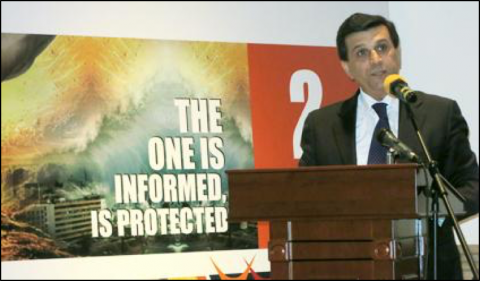Stepanavan, Armenia- City Resilience Plan a Catalyst for Change

Armenian Minister of Territorial Administration and Emergency Situations, Mr Armen Yeritsyan, urges use of World Conference for DRR in Sendai, Japan, as a springboard to future resilience. © UNISDR
The government of Armenia assigned a high priority to disaster risk reduction and looked to improve disaster resilience at the local level, particularly in Stepanavan, one of the country’s most earthquake-prone cities, which was badly damaged in the 1988 Spitak earthquake. The magnitude 6.8 earthquake left 25,000 dead and 500,000 homeless. Almost 1,000 buildings either collapsed or had to be demolished. This experience, and a growing demand for disaster-resilient development, prompted Armenia to undertake a pilot project in Stepanavan. The goal is to replicate the project in 12 other Armenian cities.
Thanks to the political will of Stepanavan city Mayor Mikael Gharakeshishyan and his interest in mainstreaming disaster risk reduction and climate change adaptation into the city’s broader development plan, a City Resilience Task Force was created to assess Stepanavan’s resilience to disasters, using the UNISDR Local Government Self-Assessment Tool (LGSAT). “The first big lesson was from Spitak (a neighbouring city of Stepanavan) in that we needed to work with people so that they are aware of how they can protect themselves,” said the Hyogo Framework for Action Focal Point for Armenia, Nikolay Grigoryan. “Take myself as an example at the time. I was so unaware and experienced great frustration. We had no teachers, no textbooks. Experience was our great teacher but it charged us a lot in terms of the cost we paid. We did everything by gut feeling. Now we know that those who have skills and knowledge have more resilience.”
The UNISDR LGSAT assessment allowed Stepanavan to identify gaps in its management capacities and, based on the results, a detailed City Resilience Action Plan was developed at a workshop convened by the UNISDR Global Education and Training Institute (GETI), and later mainstreamed into the citywide development plan. After presenting the plan to donors, Stepanavan received funding support from the national government as well as four agencies already working in Armenia: UNDP; UNOCHA; World Vision; and the Armenian Red Cross.
Please find additional information at:
http://www.unisdr.org/archive/40965
http://www.unisdr.org/archive/38708
UNISDR's 'Making Cities Resilient Campaign'
UNISDR launched the Making Cities Resilient Campaign in 2010 and through it has developed a global network of more than 2,500 local governments committed to reducing risk and building more resilient cities. These local governments represent cities of different sizes, characteristics, risk profiles and locations. Their efforts are reinforced by a supportive group of partner organizations.
The Campaign’s focus is on disaster resilience – that is, the ability of a city to plan for, mitigate, respond, recover, adapt and grow after major in the light of its unique physical, economic, environmental and social circumstances. On a spectrum ranging from chronic stresses (environmental, social or economic imbalances) through to acute stresses, disasters are at the acute pole, but may be exacerbated by a background of chronic stress – where for example upstream deforestation increases the propensity for as hooding, or where economic imbalances hinder the recovery process.
“It is clear that the risk in cities is growing faster than our ability to reduce them. We need to innovate and ensure that solutions, tools and methods for resilience building are not only available, but also accessible. We need to accelerate resilience building at the local level, and this partnership will contribute to do this.”
- Margareta Wahlström at the Third UN Conference on Disaster Risk Reduction in Sendai, Japan in March, 2015.
